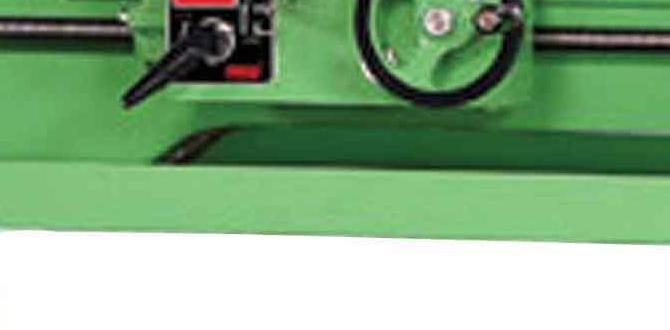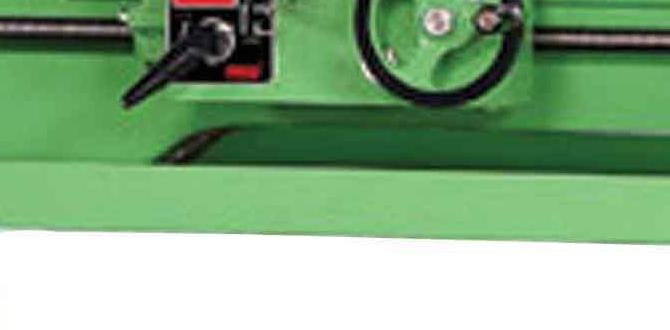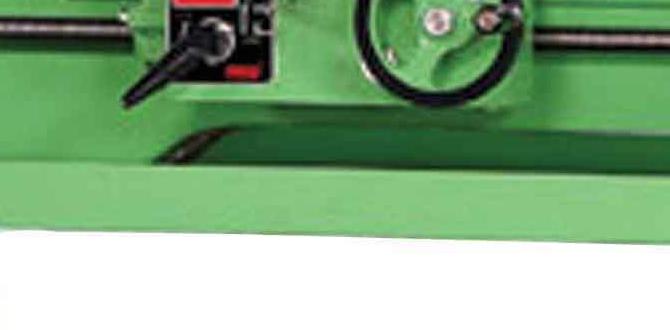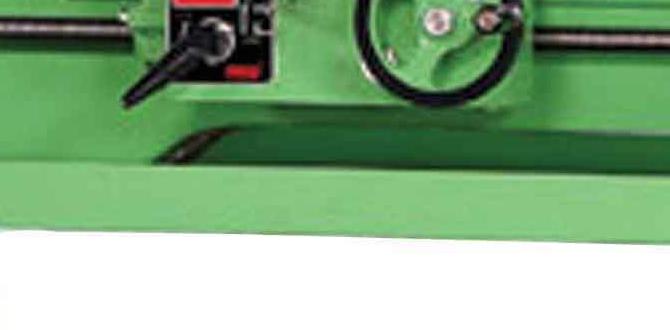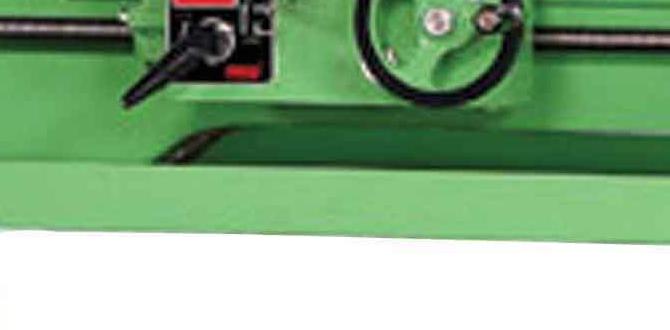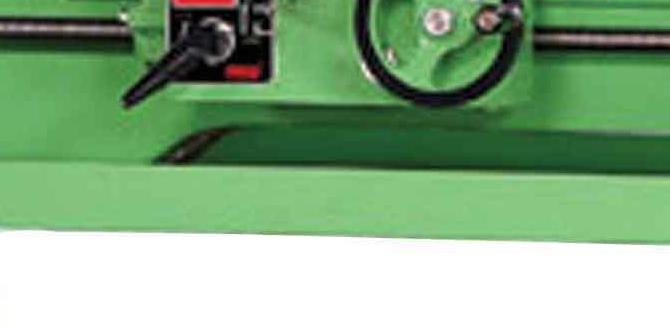Don’t let wood lathe vibrations slow you down! This guide reveals genius DIY solutions to dampen those annoying shimmies, ensuring smoother cuts, better finishes, and a safer workshop. Master vibration control with simple, effective methods designed for beginners.
Hey there, fellow makers and workshop enthusiasts! Daniel Bates here, your guide from Lathe Hub. If you’ve ever worked with a wood lathe, you know the struggle. That constant shaking and rattling can turn a satisfying woodworking session into a frustrating battle. It messes with your cuts, ruins your finishes, and can even make your machine feel unstable. But don’t worry! Today, we’re diving deep into practical, budget-friendly DIY solutions for wood lathe vibration dampening that will make a world of difference. We’ll transform that shaky lathe into a smooth-running powerhouse, so you can focus on creating beautiful projects.
Why Does My Wood Lathe Vibrate? Understanding the Shakes
Before we jump into fixing things, let’s understand why vibrations happen on a wood lathe. It’s like knowing what’s wrong with your car before taking it into the shop! Most of the time, vibration isn’t a sign of a serious mechanical failure, but rather a combination of factors related to the workpiece, the machine itself, or the environment it’s in.
Common culprits include:
- The Workpiece Itself: An unbalanced blank is the biggest offender. If you’re turning a round piece that’s not perfectly centered, or if it has irregular shapes or knots, it will wobble. This is especially true when you start with a rough, un-squared log.
- Lathe Stability: Is your lathe bolted securely to a solid base? A lightweight or mobile lathe can easily shake itself around, especially when working with denser woods or larger pieces. The floor beneath your lathe also plays a big role.
- Tooling Issues: Dull or improperly ground turning tools can cause the wood to catch and vibrate. Similarly, using the wrong tool for the job or applying too much pressure can introduce unwanted movement.
- Machine Condition: Worn bearings, loose bolts, or a damaged drive center/spur center can all contribute to vibrations. Regular maintenance is key!
- Drive System: Sometimes, the belt drive or motor itself can cause minor vibrations if they’re not running smoothly.
The good news is that most of these issues can be addressed with simple adjustments, some readily available materials, and a bit of DIY ingenuity. Let’s get to the fun part – stopping those shakes!
DIY Wood Lathe Vibration Dampening: Genius Solutions
Now for the exciting part! These DIY solutions are designed to be easy to implement, cost-effective, and highly effective for beginner woodturners. We’ll cover everything from stabilizing the lathe itself to optimizing your setup.
1. The Rock-Solid Base: Building a Stable Foundation
Your lathe’s stability is paramount. A shaky lathe is noisy, inaccurate, and potentially dangerous. If your lathe is on a wobbly stand or just a workbench, it’s time to give it a solid home. This is arguably the most important step for any DIY dampening strategy.
Option A: The Heavy, Fixed Base
This involves building a substantial base for your lathe. The heavier and more rigid the base, the better it will absorb vibrations.
Materials:
- Thick plywood (3/4 inch or thicker) or MDF
- Dimensional lumber (2x4s or 4x4s)
- Wood screws (appropriate length for your lumber)
- Wood glue
- Optional: Heavy concrete blocks or weight plates
Steps:
- Design: Measure your lathe’s mounting points and create a base that is slightly larger than the lathe itself. Aim for a design that incorporates cross-bracing for rigidity. A common approach is to create a box frame.
- Cut Lumber: Cut your 2x4s or 4x4s to size for the base frame and any internal support beams.
- Assemble Frame: Using wood glue and screws, assemble the base frame. Ensure all joints are square and tight. For extra stability, consider using metal brackets at the corners.
- Add Plywood/MDF Top: Cut a piece of thick plywood or MDF to fit over the top of your frame. Secure it firmly with wood glue and screws. This will be the surface your lathe mounts to.
- Mount Lathe: Position your wood lathe on the new base and mark the mounting holes. Drill pilot holes and securely bolt the lathe to the base.
- Add Weight (Optional but Recommended): For extreme vibration dampening, you can build compartments into the base to hold heavy materials like sand, gravel, or even secure concrete blocks. This mass will absorb a tremendous amount of vibration.
Option B: The Mobile Base Upgrade
If you need to move your lathe around, a simple fixed base won’t cut it. However, many commercial mobile bases can be upgraded for better vibration control.
Modification Steps:
- Choose a Sturdy Mobile Base: Invest in a heavy-duty mobile base designed for shop equipment. Look for ones with large diameter casters and a robust frame.
- Add Isolation Pads: Place thick, dense anti-vibration rubber pads (often sold for washing machines or heavy machinery) between the mobile base and your lathe’s feet. This is crucial.
- Secure Lathe to Base: Bolt your lathe directly to the mobile base frame. Don’t just rest it there; use bolts for a secure connection.
- Lock Down Casters: Always lock the casters firmly when the lathe is in use.
External Resource: For more on building stable shop bases, check out this excellent guide on workbench construction from Popular Mechanics. While for workbenches, the principles of stability and rigidity apply directly to lathe bases.
2. Underneath the Feet: Isolation Pads and Materials
Even on a sturdy base, placing isolation materials directly under your lathe’s feet can make a huge difference. These materials absorb shock and prevent vibrations from transmitting into the floor or workbench.
Recommended Materials:
- Dense Rubber Mats: Look for anti-vibration pads designed for heavy machinery, washing machines, or even gym flooring. The denser, the better.
- Neoprene Rubber: This material offers good shock absorption. You can often buy it by the sheet.
- Cork Pads: Natural cork can be surprisingly effective at dampening high-frequency vibrations.
- DIY Layers: You can even stack layers of different materials like cork and rubber for a custom dampening effect.
How to Use Them:
- Cut the material to fit around or under your lathe’s existing feet.
- Ensure the material is thick enough (at least 1-2 inches is ideal for significant impact).
- Place your lathe on top of these pads.
A Note on Sorbothane:
While pricier, materials like Sorbothane are exceptionally good at absorbing shock and vibration. If you’re dealing with persistent, heavy vibration, a small amount of Sorbothane under the feet can be a game-changer. You can buy it in sheets or pre-cut pucks.
3. Balancing the Workpiece: The First Line of Defense
As mentioned, an unbalanced turning blank is the #1 enemy of a smooth lathe. Preventing this starts before you even mount the wood.
Tips for Better Balancing:
- Start with Square Stock: Whenever possible, mount your blank with its corners aligned to the drive and tail centers. If you’re turning a square or rectangular block, this significantly reduces initial wobble.
- Rough Turning Technique: When turning a round shape from a square, start by rounding the corners carefully. Don’t try to take huge shavings from the corners. Gradually remove material, working down towards the desired cylinder.
- Check for Cracks and Knots: Inspect your wood blank for any cracks, loose knots, or rot. These can cause imbalance and are safety hazards. Avoid them or prepare them appropriately (e.g., filling with epoxy).
- Center Your Blank: Use a compass or a measuring tool to find the center of your blank and mark it clearly. This helps in accurately mounting it to your drive center.
- Use a Good Drive System: Ensure your spur drive and live center are sharp and properly seated to give the wood a firm grip and good support. A bent spur drive is a vibration generator!
4. Tooling and Technique: Smooth Cuts = Smooth Lathe
The tools you use and how you use them have a direct impact on vibration. Think of it like scraping versus shaving with a razor – one is rough, the other is smooth.
Tool Sharpening is Key
Dull tools don’t cut; they tear. A torn cut introduces uneven resistance, leading to bumps and vibrations.
- Regular Sharpening: Make it a habit to sharpen your tools frequently. A sharp edge glides through the wood with minimal force.
- Proper Grinding Angles: Learn the correct grind angles for your specific tools (gouges, skew chisels, scrapers). The angle affects how the tool cuts and interacts with the wood.
- Honing: Use a honing guide and fine grit stones or strops to keep a keen edge between grinds.
Technique Matters
The way you present the tool to the wood makes a big difference.
- Let the Tool Do the Work: Don’t force the tool. Apply steady, controlled pressure.
- Use Shear Cuts: For many operations, especially with bowls, using a shear scraping or scraping cut at an angle to the grain is smoother than a direct cut against the grain.
- Support Your Tools: Always use the tool rest close to the work. This provides leverage and control, preventing the tool from digging in or bouncing.
- Take Lighter Cuts: Especially when starting out or working with challenging wood, lighter, more frequent cuts are better than one aggressive pass.
5. Sanding and Finishing: The Final Polish
Vibrations during sanding are particularly frustrating because they mar the surface you’re trying to smooth. Dampening the lathe helps, but there are also techniques to improve sanding.
DIY Sanding Aids for Vibration Control
- Sandpaper Glues: Sometimes, a bit of paste wax or specialized sanding lubricant applied to the wood surface can help sandpaper glide more smoothly, reducing the tendency to catch and vibrate.
- Interrupted Sanding: Periodically stop sanding and check your progress. This gives the wood and lathe a moment to settle and can prevent the build-up of heat and dust that exacerbates vibration.
- Dedicated Sanding Attachments: For dust collection and smoother results, consider or DIY some simple sanding blocks that conform to the wood’s shape and allow for even pressure.
6. The “Weighty” Solution: Adding Mass to the Lathe
Sometimes, the lathe itself needs more heft. You can add weight directly to the lathe bed or legs to help absorb vibrations.
DIY Weighting Methods:
- Sandbags or Weight Plates: Securely strap or bolt heavy sandbags or weight plates to the lathe’s legs or frame. Ensure they are firmly attached so they don’t shift during operation.
- DIY Weight Boxes: Build small, sturdy boxes that attach to the lathe legs. Fill these with sand, gravel, or lead shot (use caution and proper ventilation with lead shot).
- Magnetic Weights: If your lathe bed has ferrous metal, you can use strong, industrial magnets to attach steel plates or weights. This is a less permanent option.
Safety Note: Always ensure that any added weight is securely fastened and does not interfere with the operation of the lathe or its moving parts. Sudden shifting of weight can be as dangerous as vibration itself.
7. Addressing the Unseen: Lubrication and Maintenance
Don’t forget the basics! A well-maintained lathe runs smoother.
- Lubricate Bearings: Check your headstock and tailstock bearings. If they are easily accessible, ensure they are properly lubricated according to your lathe’s manual.
- Tighten Bolts: Periodically check and tighten all bolts and fasteners on your lathe frame, tool rest banjo, and headstock/tailstock. Loose parts are prime vibration sources.
- Check the Drive System: Inspect the belt for wear or damage. Ensure the motor mounts are secure and the pulleys are balanced.
- Clean Regularly: Wood dust can accumulate in ways that affect balance and smooth operation. Keep your lathe clean.
External Resource: For general lathe maintenance tips, consult manufacturer manuals or resources like Woodworkers Institute, which often covers safety and maintenance for various tools.
Troubleshooting Common Vibration Issues
Let’s put these solutions into practice with some common scenarios.
| Symptom | Likely Cause | DIY Solution(s) |
|---|---|---|
| High-pitched Whine/Buzz | Fast-spinning unbalanced workpiece, loose tool rest, or motor issues. | Balance blank better, tighten tool rest firmly, ensure motor belt is snug but not overly tight, add isolation pads under lathe feet. |
| Heavy Banging/Thumping | Severely unbalanced blank, loose headstock/tailstock, or very unstable lathe stand. | Start rough turning carefully, tighten headstock/tailstock securely, build a heavy fixed base or add substantial weight to the current stand, use isolation pads. |
| Lathe “Walks” Across Floor | Lightweight lathe, no bolting down, smooth floor surface. | Bolt lathe to a heavy base, use rubber isolation pads, consider bolting base to floor (if stationary), ensure mobile base casters are locked AND that the base itself has some heft. |
| Rough Surface Finish Even with Sharp Tools | Lathe vibration, dull tools, or incorrect tool presentation. | Implement all dampening solutions, sharpen tools meticulously, practice shear cuts, ensure tool rest is very close to the wood. |
FAQ: Your Wood Lathe Vibration Questions Answered
Q1: My lathe is new and still vibrates. What’s wrong?
A: Even new lathes can vibrate if not set up correctly. The most common cause is an unbalanced workpiece. Always start by ensuring your wood blank is as centered and balanced as possible for rough turning. Also, check that your lathe is on a level, stable surface and that its feet are making firm contact or are placed on isolating pads. New machines might also have shipping packing material that needs to be fully removed.
Q2: Is it safe to put heavy weights on my wood lathe?
A: Yes, adding weight to the base or legs of your lathe is a very common and effective method for vibration dampening. The key is that the weight must be securely fastened so it cannot shift during operation. Never place weights directly on moving lathe parts or in a way that could cause instability.
Q3: How do I know if my wood blank is unbalanced?
A: When you first start the lathe at a slow speed, an unbalanced blank will visibly wobble or bounce. The effect is much more pronounced with larger or irregularly shaped blanks. If you see significant movement immediately upon starting, your blank is likely unbalanced.
Q4: Can I use old car tires under my lathe?
A: While rubber is good for dampening, a whole car tire might be too soft and unstable for a wood lathe, especially for heavy-duty turning. It could allow too much movement. It’s better to use denser, purpose-made anti-vibration pads or thick, dense rubber sheeting designed for heavy machinery. These provide support and dampening without excessive flex.
Q5: What is the best vibration dampening material for under a lathe?
A: The best material is often a combination of density and firmness. Thick, dense rubber mats designed for industrial machinery or heavy-duty fitness flooring are excellent. Neoprene rubber sheeting, cork pads, or even specialized anti-vibration mounts for appliances can also work well. The goal is something that absorbs impact without deforming too much.
Q6: My tailstock vibrates. What can I do?
A: A vibrating tailstock is often caused by the live center not being securely seated in the tailstock quill, or the wood


